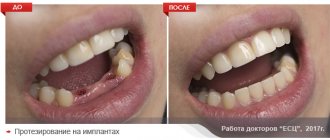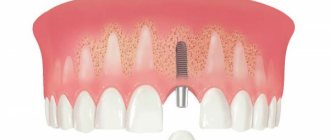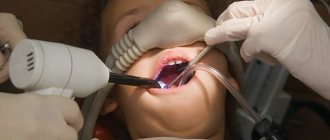Many people have heard that it is possible to perform dental treatment under general anesthesia. This practice is especially often used in pediatric dentistry, when it is necessary to carry out a large amount of dental work, and the child does not communicate well with doctors or is simply afraid. However, sometimes patients confuse the concepts of dental treatment under sedation and treatment under anesthesia - these are two completely different methods.
What is sedation dental treatment?
Sedation is a method of pain relief based on immersing the patient in a relaxed “drowsy” state by inhaling a nitrogen-oxygen mixture or intravenous administration of sedatives. There are two types of such anesthesia: deep sedation, when the patient is in a state of deep sleep and does not respond to external stimuli, and superficial, in which the patient is half asleep, completely retains breathing and is able to hear and follow the doctor’s instructions. In dentistry, dental treatment with superficial sedation is usually used. This method allows you to eliminate discomfort from dental procedures, relieve fear and ensure the absence of stress.
At the same time, the need to carry out conventional local anesthesia remains, since the patient remains able to feel pain. Therefore, the technique involves putting the patient into a state of half-asleep followed by anesthesia - this ensures complete comfort and painlessness of therapeutic procedures.
Wisdom tooth removal surgery
The procedure can be quite simple or complex. In the first case, local anesthesia is possible; Ultracaine is usually used. In case of difficulties, removal of wisdom teeth under general anesthesia is required, since the operation takes a long time and involves specific manipulations.
The preliminary stage begins with collecting anamnesis, conducting examinations and tests. This is a necessary set of measures before surgery under general anesthesia. The doctor clarifies the presence of allergies and contraindications.
Is it painful to have a wisdom tooth removed?
The procedure is absolutely painless, since local or general anesthesia is used to remove wisdom teeth if indicated. With local anesthesia, the patient does not experience pain, but may feel discomfort from manipulation. Anesthesia for wisdom tooth removal is indicated for people who experience panic before the procedure, as well as in complex cases when several teeth need to be removed at once, or with intolerance to local anesthetics.
After the effect of the anesthetic wears off, discomfort may appear during wisdom tooth removal. To relieve pain, the doctor prescribes analgesics.
Removal of impacted wisdom tooth
To avoid inflammation and restore the proper functioning of the remaining teeth, and to prevent changes in the bite, dentists recommend removing the impacted tooth.
This is a fully formed tooth that remains in the jaw, or a partially erupted tooth. Eruption may be asymptomatic or with complications and pain.
Removal of an impacted wisdom tooth is necessary in the following cases:
- loosening or loss of adjacent teeth;
- swelling and growth of the gums;
- crown caries;
- the occurrence of an inflammatory process;
- damage to the internal tissue of adjacent teeth.
- the occurrence of tumor growth (cysts).
To clarify the depth of the tooth and the direction of its growth, radiography is used. Orthopantomography and CT are also used. After examining and studying the results of the examination, the dentist decides on the need to remove the impacted wisdom tooth.
This is a complex operation that requires preparation. The doctor checks the tolerability of anesthesia drugs, clarifies the presence of chronic diseases and, if necessary, refers for consultation to specialists.
Before the procedure, you should avoid taking blood thinning medications. Patients suffering from hypertension are recommended to take medications to lower blood pressure.
Procedure steps:
- local or general anesthesia for wisdom teeth removal;
- incision in the gum, creating access to the tooth lying in the bone tissue
- gentle resection of the bone covering the tooth using an ultrasound device and piezotone;
- crown removal, root separation and extraction;
- cleaning the surface from bone tissue and treating with an antiseptic;
- suturing.
Before the procedure, you should avoid taking blood thinning medications. Patients suffering from hypertension are recommended to take medications to lower blood pressure.
Removal of lower wisdom tooth
The lower row of teeth experience more stress than the upper ones. They are more massive, they have stronger roots, which have a sinuous shape. Therefore, removing wisdom teeth in the lower jaw is more difficult.
There are two types of operations to remove lower wisdom teeth. With a simple intervention, an incision of the gum and drilling of the bone are not performed. The dentist uses forceps and an elevator. The procedure lasts no more than 1 hour.
Complex removal of wisdom teeth in the lower jaw involves an incision in the mucous membrane and the use of a drill. The operation is indicated for a recumbent or unerupted molar, when it is located in the thickness of the bone and there is no access to it. This procedure takes several hours. The cost of complex removal of lower wisdom teeth is 6,480 rubles, impacted teeth are 10,815 rubles.
Removal of the upper wisdom tooth
Unlike the lower ones, the upper eights are considered less complex. They grow more evenly and their roots are rarely curved or long. When removing a wisdom tooth in the upper jaw, the likelihood of affecting the trigeminal nerve is minimal.
The simple procedure does not involve dissection of the gums and is carried out in 4 stages:
- X-ray or CT scan to determine bone structure and tooth position;
- anesthesia (usually local);
- rocking and pulling with forceps;
- treatment of the hole after removal of the wisdom tooth from above and suturing (if necessary).
Complications when removing the figure eight
The structural features of molars can lead to complications during and after surgery.
During surgery, tooth decay may occur. This happens when the enamel is damaged by caries or too much pressure. At the same time, a characteristic cracking sound is heard. In such a situation, the doctor resorts to carefully removing the decayed wisdom tooth and removing all the fragments from the socket.
During rough work, a jaw bone may break off when a part of the alveolar process is captured with a tooth. Sometimes broken wisdom teeth need to be removed. Specialists use special equipment to thoroughly clean the socket from bone tissue residues.
The following complications are typical in the postoperative period:
- heavy bleeding;
- inflammation inside the hole with suppuration;
- severe pain;
- stomatitis.
Wisdom tooth removal for pregnant women
Women carrying a child are recommended to undergo surgery in the second trimester. This is due to the increased risks during wisdom tooth extraction during pregnancy. In the first third of the term, it is prohibited to use anesthesia; it is dangerous for the fetus. From the seventh month of pregnancy, the risk of premature onset of labor increases. For this reason, wisdom tooth removal during pregnancy in the first and third trimester is carried out only in emergency cases.
In the second trimester, the list of permitted anesthetics is limited. When choosing drugs for removing wisdom teeth during pregnancy, take into account the impossibility of the drug penetrating the placenta. The procedure can be carried out during breastfeeding, but it must be taken into account that you cannot breastfeed until the medications are removed.
Removing a child's wisdom tooth
The decision to remove wisdom teeth in children is always made individually, with a mandatory consultation with an orthodontist.
Indications for extraction are:
- inflammation of the soft tissue of the gums, when cutting the hood does not solve the problem;
- crowding of the dentition, there is no room for the eruption of the figure eight;
- incorrect location when teeth, mucous membranes, cheek, tongue are injured;
- pulpitis, figure eight caries, the treatment of which is complicated by an inconvenient location.
Before removing a teenager's wisdom teeth, the doctor administers anesthesia and makes sure it works. First, the gum is peeled off or cut. Next, forceps and an elevator are used. In case of complex removal, a preliminary cut is made and the tooth is removed in parts. The doctor acts carefully and painlessly for the child.
Indications and contraindications
Indications for dental treatment under sedation are:
- Patient's fear of dental procedures.
- Childhood. Dental treatment under sedation is especially often used in pediatric dentistry, since it is much more difficult for a child to spend 50-60 minutes or more calmly in the dental chair.
- The need for complex therapy of many teeth at once or complex removal.
- Serious discomfort during any dental procedures.
- Hypertension – so that stress during therapeutic procedures does not cause an increase in blood pressure.
Contraindications include alcohol or drug intoxication, pregnancy, certain types of mental disorders, the presence of traumatic brain injuries, and age less than three years. Also a contraindication is the patient’s individual allergic reaction to local anesthetics.
What drugs do we use?
- Sevoran
(Great Britain). An inhalational anesthetic that provides rapid induction of anesthesia. We have been using this drug in anesthesia treatment for more than 15 years - in adults and children.
- Supran
(Baxter company, USA). Anesthesia with this drug is available in our clinics on Prospekt Mira and Novye Cheryomushki. Studies show that Supran is eliminated from the body faster, which means that patients recover more quickly after waking up - full activity within 1 hour after completion of treatment. This drug is especially relevant for long-term anesthesia - 3 hours or longer. You will decide which anesthesia drug is ideal in your case together with your anesthesiologist during your consultation.
How dental treatment is performed under sedation in children and adults, reviews
In pediatric dentistry with sedation, a nitrogen-oxygen mixture (70% nitrogen, 30% oxygen) is most often used, which the child inhales through a special mask. Adults are usually offered intravenous administration of a sedative, but the “mask” method can also be used if desired.
The sedative effect occurs within 4-5 minutes. The procedure itself is completely safe, including for small patients - it does not give any euphoric or consciousness-suppressing effect, it only produces a calming and relaxing effect. This way, the person becomes more tolerant of the treatment and can sit calmly in the dental chair longer. In this case, the doctor is in complete control of the situation, because he can freely communicate with the patient.
Dental treatment under sedation, according to patient reviews, is a fairly comfortable procedure that allows not only to effectively eliminate nervousness when visiting a dentist, but also to reduce the number of such visits, since more work can be completed in one visit.
What are the advantages of treatment under anesthesia in our clinic?
- We use only advanced and safe drugs for anesthesia - they have passed mandatory certification;
- Using general anesthesia, our clinic’s specialists can implant, treat or remove several teeth at once. This allows you to significantly reduce treatment time;
- A team of anesthesiologists - a doctor and his assistant - always works during anesthesia. The anesthesiologist fully monitors the patient’s body condition throughout the entire treatment using an advanced monitoring system;
- we provide a full service: we provide a set of compression garments, and after anesthesia the patient wakes up in a cozy sleep room under the supervision of the attending physician.











